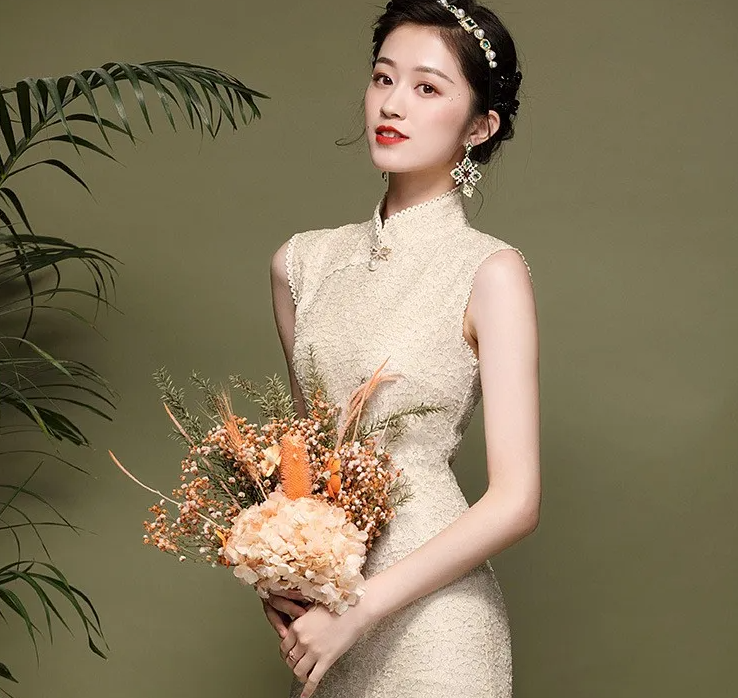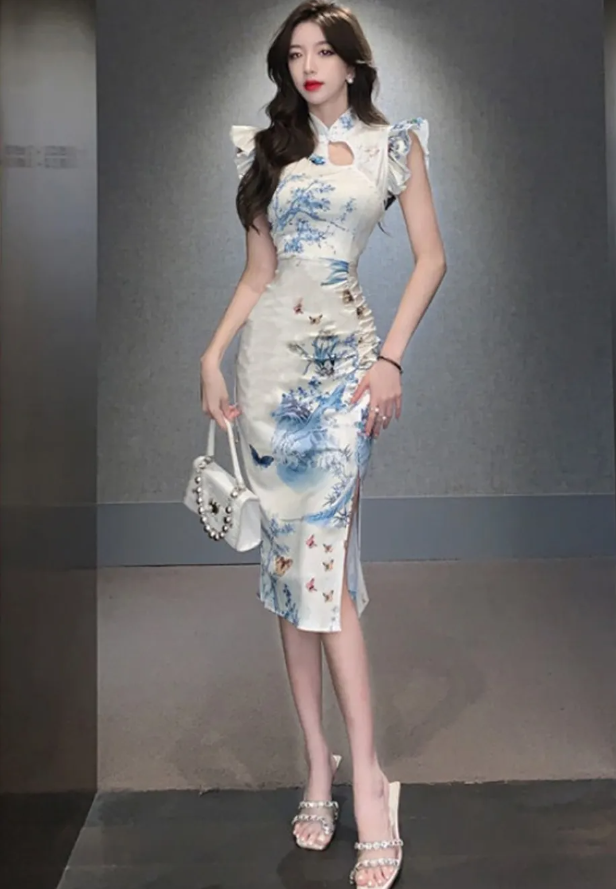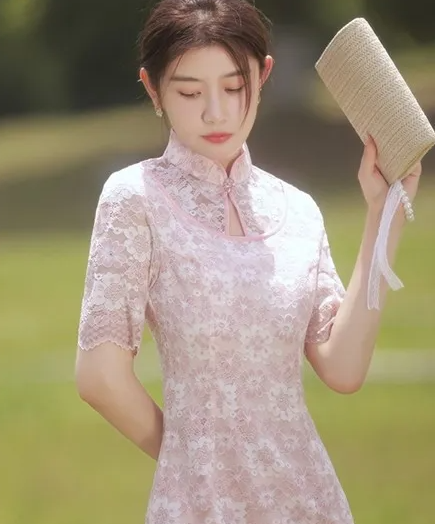A cheongsam should fit snugly, accentuating natural curves, with correct collar placement and appropriate hem length.
Fundamental Principles of a Well-fitting Cheongsam
The cheongsam, often referred to as qipao in Mandarin, is a hallmark of traditional Chinese fashion, representing elegance, sophistication, and a rich cultural heritage. To truly appreciate its beauty, understanding the principles of its fit is essential. This ensures not only aesthetic appeal but also comfort when wearing this iconic dress.

Importance of Tailoring in Traditional Chinese Fashion
In traditional Chinese fashion, the art of tailoring has always been highly revered. The cheongsam, like other traditional outfits, is not merely a piece of fabric stitched together. It’s a craft.
- Precision: Tailoring is all about precision. A slight misalignment or a minor discrepancy in measurement can affect the overall look of the dress. For instance, a perfectly tailored cheongsam should have its side slits aligned accurately, starting approximately 5-6 inches above the knee.
- Customization: The essence of tailoring lies in its ability to cater to individual body shapes and sizes. Unlike western outfits, which often prioritize ease and speed of production, traditional Chinese outfits like the cheongsam emphasize personal customization. Each dress should reflect the wearer’s unique body contours and personality.
- Material Choice: The choice of fabric is crucial in tailoring. Traditional materials like silk require expert handling, ensuring that the seams are invisible and the fabric drapes elegantly. On the other hand, modern fabrics like polyester blends might offer more flexibility and durability but require different tailoring techniques.
Key Measurements for the Perfect Fit
Getting the right measurements is the first and perhaps the most crucial step in ensuring a well-fitting cheongsam. Here’s a breakdown:
- Bust: Measure around the fullest part, ensuring the tape is snug but not tight. For a classic cheongsam fit, there should be a leeway of about 1-1.5 inches for ease.
- Waist: Find the natural waistline, usually the narrowest part of the torso. Again, an additional 1-inch leeway is typical for a comfortable fit without compromising the dress’s shape.
- Hips: Measure around the fullest part of the hips. Given the tapered design of the cheongsam, a 1.5-2 inches allowance is recommended.
- Shoulder Width: Measure from the edge of one shoulder to the other. A well-fitted cheongsam should allow smooth movement without any strain on the seams.
- Dress Length: Depending on personal preference and the occasion, the length can vary. Traditionally, the cheongsam ends just below the knee, but modern variations might be longer or shorter.
- Sleeve Length: Traditional cheongsams often feature shorter sleeves, ending just above the elbow. However, there are designs with full-length sleeves, especially for formal occasions.
Specifics of a Proper Cheongsam Fit
The charm of the cheongsam lies not just in its history or its symbolism, but also in its fit. When fitted correctly, it exudes grace and elegance, seamlessly merging the body’s natural curves with the intricate design of the dress. Let’s delve into the specifics of achieving this perfect fit.
Neckline and Collar Considerations
The cheongsam’s distinctive high collar not only carries cultural significance but also requires precision in fitting.
- Height: The collar typically stands at around 2-3 inches. Too high, and it might cause discomfort to the throat. Too low, and it loses its traditional appeal.
- Tightness: The collar should sit comfortably around the neck without causing any strain. A finger’s width of space between the collar and neck usually indicates a good fit.
- Shape: The shape can vary based on personal preference. Some prefer the classic rounded Mandarin collar, while others might lean towards a more pointed or modern design.
Snugness at the Bust and Waist
Achieving the right snugness ensures both comfort and aesthetic appeal.
- Bust: The dress should sit smoothly around the bust area, avoiding any wrinkles or strains. An allowance of about 1-1.5 inches ensures ease of movement.
- Waist: Traditionally, the cheongsam highlights the waist. However, it shouldn’t be too tight. Like the bust, a 1-inch allowance typically suffices.
Hip and Thigh Contouring
The lower part of the cheongsam is equally important in defining its elegance.
- Hips: The dress should gracefully trace the hip’s contour without being too tight. A 1.5-2 inches leeway is recommended.
- Thighs: As the dress tapers down, it should not constrict the thighs. This ensures ease while walking, especially considering the side slits.
Sleeve Length and Width
Sleeves play a pivotal role in defining the cheongsam’s overall look.
- Length: Traditional cheongsams often have sleeves ending just above the elbow. However, variations include short-capped sleeves or full-length ones for formal events.
- Width: The sleeves should allow for comfortable arm movement. Typically, a 0.5-1 inch allowance from the arm ensures this without causing the fabric to stretch or tear.
Hemlines and Slit Placement
The finishing touches to the cheongsam are vital for movement and style.
- Hemlines: Depending on personal preference and the occasion, the dress’s length can vary. However, it traditionally ends just below the knee.
- Slit Placement: The iconic side slits start approximately 5-6 inches above the knee, ensuring ease of movement and a subtle showcase of the legs.
Choosing the Right Fabric
Selecting the right fabric for a cheongsam is akin to choosing the soul of the dress. It defines how the dress feels, how it fits, and how it moves with the body. As such, understanding fabric choices is crucial for anyone looking to invest in or create the perfect cheongsam.
Traditional Fabrics Used in Cheongsams
Historically, the fabric used for cheongsams reflected one’s social status and occasion.
- Silk: The most revered fabric in Chinese culture, silk offers a soft, smooth texture and a natural sheen. It drapes beautifully and gives the cheongsam a luxurious feel. Depending on the quality, silk prices can range from $20 to $500 per yard. Authentic silk cheongsams, especially those with intricate patterns, can be priced upwards of $1000.
- Brocade: This is a rich, decorative shuttle-woven fabric, often interwoven with colorful threads, typically silver or gold. Used for more formal cheongsams, brocade gives the dress a regal look.
- Satin: Known for its glossy surface and a dull back, satin offers a more affordable alternative to silk while still providing an elegant sheen.

Modern Fabric Choices and Their Impact on Fit
As the cheongsam has evolved, so have the fabric choices, with many modern iterations considering comfort, durability, and cost.
- Cotton and Cotton Blends: Known for its breathability, cotton offers a comfortable option, especially for casual or everyday wear. Cotton cheongsams might range from $50 to $200, depending on the design and craftsmanship.
- Polyester and Blends: These are more durable and often more affordable than natural fibers. They resist wrinkles and hold color well. However, they might lack the natural feel of traditional fabrics. A typical polyester cheongsam can cost between $40 and $150.
- Velvet: Offering a soft, plush feel, velvet adds a touch of luxury and is often chosen for winter cheongsams due to its heavier weight.
Understanding Fabric Stretch and Draping
The way a fabric stretches and drapes is pivotal for the cheongsam’s fit.
- Stretch: Fabrics like spandex or those with elastane offer stretch, which can make the cheongsam more forgiving and comfortable. However, too much stretch can deviate from the traditional snug fit of the dress.
- Draping: This refers to how the fabric falls or hangs on the body. Fabrics like silk and satin drape smoothly, closely following the body’s contours, while stiffer fabrics like brocade might offer a more structured look.
Potential Fit Issues and Their Solutions
Even with the best intentions, finding a cheongsam that fits perfectly right off the rack can be a challenge. Whether it’s due to standardized sizes not aligning with individual body shapes or discrepancies in design, fit issues are common. Let’s explore these issues and discover solutions to ensure your cheongsam fits like a dream.
Common Problems with Off-the-Rack Cheongsams
Buying ready-made cheongsams, while convenient, often presents a host of fit challenges.
- Collar Gaps: One frequent problem is a gap between the collar and the neck. This issue can result in an ill-fitted look and detract from the dress’s elegance.
- Bulging at the Bust: An overly tight fit around the bust can lead to unsightly bulges or stretch marks on the fabric, compromising the dress’s aesthetic appeal.
- Misaligned Slits: The iconic side slits can sometimes be placed too high or too low, affecting both movement and style.
- Inconsistent Hemlines: A hemline that’s too short or too long can impact the overall proportions and aesthetic of the dress.
Tips for Adjusting a Misfit Cheongsam
Thankfully, many common fit issues can be addressed with a few adjustments.
- Collar Adjustments: If there’s a gap at the collar, consider adding a hook or snap button to secure it closer to the neck. This small change can make a world of difference in the dress’s fit and appearance.
- Darts and Tucks: For bulging at the bust or waist, introducing darts or tucks can help in reshaping the dress to better fit the body’s contours.
- Slit Alterations: If the slit placement is off, it can often be adjusted by a few inches to achieve the desired look and functionality.
- Hemming: Adjusting the hemline can drastically change the dress’s appearance. Whether it’s shortening or lengthening the hem, this modification can ensure the cheongsam ends at the ideal spot just below the knee.

When to Consult a Professional Tailor
While some minor adjustments can be made at home, certain fit issues require a professional’s touch.
- Resizing: If the dress is several sizes too large or small, it’s wise to consult a tailor. They possess the skills and tools to resize the cheongsam without compromising its integrity.
- Material Challenges: Some fabrics, like silk or brocade, are challenging to work with. A tailor can navigate these materials with ease, ensuring the alterations don’t damage the dress.
- Cost vs. Value: The price of tailoring can vary, ranging from $50 to $300, depending on the complexity of the work. However, investing in professional tailoring ensures the longevity and quality of the dress, often making it a worthy investment.
Incorporating Personal Style
The cheongsam, while rooted in tradition, offers ample room for personal expression. Today’s fashion landscape encourages individuals to take traditional garments and make them their own. Let’s dive into how you can infuse personal style into your cheongsam, making it a unique reflection of who you are.
Modern Interpretations and Adaptations of the Cheongsam
Modern designers have creatively reimagined the cheongsam, introducing a blend of tradition and contemporary style.
- Length Variations: While the traditional cheongsam ends just below the knee, modern adaptations can be found in mini, midi, and maxi lengths. This variety allows individuals to select a length that aligns with their style and comfort.
- Sleeve Designs: Beyond the conventional short or cap sleeves, today’s cheongsams can sport sleeveless, long-sleeve, or even off-shoulder designs. This diversity offers an array of choices to suit different climates and style preferences.
- Mix of Fabrics: Modern cheongsams sometimes incorporate materials like denim, leather, or mesh, offering a fresh and edgy look.
Accessorizing Your Cheongsam
Accessories can elevate the look of a cheongsam, adding depth and personal flair.
- Jewelry: Depending on the neckline, a statement necklace or elegant earrings can enhance the dress. However, with intricate patterns, it’s better to opt for simpler jewelry to avoid overpowering the dress.
- Shoes: High heels, especially stilettos, often complement the snug fit and elongated form of the cheongsam. However, for a more relaxed look, flats or even sneakers can work.
- Bags: Clutches or small handbags usually pair well with the cheongsam, maintaining its elegance. For a more modern twist, crossbody bags or tote bags can be chosen.
Choosing Patterns and Colors for Your Body Type
Colors and patterns can influence perception, making it essential to select those that flatter your body type and skin tone.
- Vertical Patterns: These elongate the body and are especially flattering for petite individuals. Stripes or vertical floral patterns can be effective choices.
- Darker Shades: Colors like navy, black, or deep red can have a slimming effect. They’re versatile and can be worn for both formal and casual occasions.
- Lighter Tones and Bright Colors: For those looking to stand out or highlight specific areas of the body, lighter and brighter colors can be effective. Shades like pastel blue, bright yellow, or even white can be eye-catching.
- Understand Body Shape: Recognizing whether you have an apple, pear, hourglass, or rectangular shape can guide pattern and color choices. For example, hourglass figures might opt for patterns that emphasize the waist, while pear shapes might choose darker colors for the lower body.